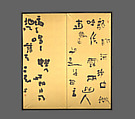Five Freestyle Haiku and a Chinese Couplet
Kawahigashi Hekigotō Japanese
The poems on this glittering gold screen are formed from deconstructed characters and presented in crooked columns, in defiance of traditional East Asian calligraphic norms. A brush dripping ink was used to create the rich tones and the strokes in the lettering, which varies radically in thickness. The artist’s approach demonstrates a deliberate avoidance of calligraphic finesse, giving an impression of playfulness and near-abstract design.
Many early twentieth-century Japanese calligraphers, including Kawahigashi Hekigotō, studied Chinese calligraphy from the Six Dynasties period (220–589), in addition to previously unknown ink rubbings from carved steles in China. Interest in these models instigated a shift toward archaism in Japanese calligraphy.
Poems on right screen: all haiku, from right to left
さくら活けた 花屑の中から 一枝拾ふ
For an arrangement of cherry blossoms—
I pick out a single branch / from among fallen petals.
夜のけはひ 鮎は生きての 酢びたし腸を
Setting the evening’s mood—
guts of fresh sweetfish / dipped in vinegar.
今宵泊らん 脚いたはりつ もみぢ濡れゐつ
Let’s not lodge tonight, and just rest our legs—
beneath the drenched autumn foliage.
炉の火箸 手にとれば 火をよせてのみ
At the hearth, I grab the fire tongs,
just to draw closer to the flames.
Left screen: poem in Chinese and haiku, from right to left:
龍眠流浄中 微吟作雲雨 幽人建徳居 知是清風主
As the dragon slumbers in the pure waters,
it chants in a quiet voice to form clouds and rain.
While the hermit builds a dwelling of virtue,
we know he controls the pure wind.
夜も鳴く 蝉の灯明りの 地に落るこゑ
Droning on, even at night—the sound of cicada
as it drops to the ground around the lamplight.
—Translations by John T. Carpenter
This image cannot be enlarged, viewed at full screen, or downloaded.
This artwork is meant to be viewed from right to left. Scroll left to view more.



